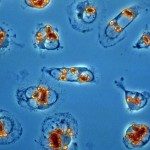Link to Pubmed [PMID] – 31975452
Link to DOI – 10.1111/mmi.14464
Mol Microbiol 2020 05; 113(5): 983-1002
Although the multiplicative and growth-arrested states play key roles in Leishmania development, the regulators of these transitions are largely unknown. In an attempt to gain a better understanding of these processes, we characterised one member of a family of protein kinases with dual specificity, LinDYRK1, which acts as a stasis regulator in other organisms. LinDYRK1 overexpressing parasites displayed a decrease in proliferation and in cell cycle re-entry of arrested cells. Parasites lacking LinDYRK1 displayed distinct fitness phenotypes in logarithmic and stationary growth phases. In logarithmic growth phase, LinDYRK1-/- parasites proliferated better than control lines, supporting a role of this kinase in stasis, while in stationary growth phase, LinDYRK1-/- parasites had important defects as they rounded up, accumulated vacuoles and lipid bodies and displayed subtle but consistent differences in lipid composition. Moreover, they expressed less metacyclic-enriched transcripts, displayed increased sensitivity to complement lysis and a significant reduction in survival within peritoneal macrophages. The distinct LinDYRK1-/- growth phase phenotypes were mirrored by the distinct LinDYRK1 localisations in logarithmic (mainly in flagellar pocket area and endosomes) and late stationary phase (mitochondrion). Overall, this work provides first evidence for the role of a DYRK family member in sustaining promastigote stationary phase phenotype and infectivity.

